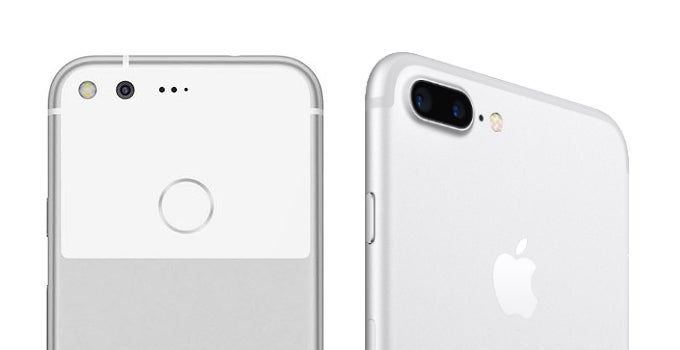iPhone 7 Plus vs Google Pixel: Portrait shootout

So, let's see which phone takes the better portraits pictures (with the oh-so-sought-after bokeh effect, of course) – the iPhone 7 Plus, or the Google Pixel?
As you can see right off the bat, the two photos look quite different perspective-wise. They were both taken from the same distance and at the same height, but the iPhone uses its telephoto lens at 2x zoom for portraits, hence the different look of the picture. Of course, I could have matched the zoom on the Pixel, but it would have been digital, not optical, which would have deteriorated the quality of the photos somewhat. I also could have moved in closer to take my shot with the Pixel, but what would be the point in that? We want to see how the two phones compare under the same circumstances.
As far as the shallow depth of field effect goes, the the Pixel obviously fares worse, as is evident from various different areas of the photo, most notably in the left portion of the models hair, right above her right (our left) shoulder. As you can see, the hair in this area appears quite blurry when viewing the photo in full size. Some of the branches in the background, on the other hand — the ones visible near the right edge of the frame, behind the tree — look completely in focus, while the others toward the center of the photo are nicely blurred.
However, to Google's credit, the actual bokeh simulation — i.e. how the light in the out-of-focus portions is rendered — looks better on the Pixel. Notice the smooth “orbs” of light in the photo on the right. They can be traced from all the way up in the branches above the model, to the ground behind here. Further, the Pixel has fared better in actually focusing on the model in this round. For some inexplicable reason, the iPhone 7 Plus did not feel like focusing squarely on the model's face in this shot (and it also left a nasty "seam" of along the length of the model's right arm).
The iPhone 7 Plus hands-down trumps it here. The close-up effect fits better and the foreground is isolated much more convincingly from the background, than on the Pixel. Here, the depth of field effect in Google camera struggles to separate subject and background, resulting in a blurry mess of a shot.
In my next test, Google's phone is yet again not quite up to snuff:
Right off the bat, despite shooting in its otherwise excellent HDR+ mode, the Pixel has decided to underexpose the result quite a bit. Other than that, the entire right portion of the shot is completely in focus, while the right side is very blurred. Our model's lush, curly hair has also fallen victim of the camera's inaccurate algorithms, as it fades into the background on one side. Further, the wider angle at which the Pixel is shooting results in some noticeable distortion around the edges, which is generally not sought-after when taking portraits.
At this point, there was no point in pushing it any further. Besides, it was getting cold outside, so we decided to head back in for one last test. This time around, I decided not to torture the Pixel with any foliage, or other complex backgrounds, and went for the simplicity of the office hallway instead:
Here, unconcerned with any complex patterns in the background, the Pixel does and adequate job. In fact, in this particular case, the phone's wider camera lends itself perfectly to creating a better illusion of depth, as it pushes the backdrop further, while the simplicity of the scene allows the software to isolate the subject in a convincing manner.
In closing, despite genuine glimmers of potential — especially when it comes to rendering the actual bokeh itself — Google's “Lens Blur” effect falls a long way short of the Portrait mode found on the iPhone 7 Plus. That's the current status quo, anyway. This year, we may see other phonemakers push the limits of software depth of field simulation further. Apple was not the first to do it, but it did it best with Portrait mode. Let's see what 2017 has in store for smartphone cameras!
Here are all the shots I took with both phones, in succession, for you to check out in their full size:
Read more:
Follow us on Google News






![Some T-Mobile users might be paying more starting in March [UPDATED]](https://m-cdn.phonearena.com/images/article/176781-wide-two_350/Some-T-Mobile-users-might-be-paying-more-starting-in-March-UPDATED.webp)









Things that are NOT allowed:
To help keep our community safe and free from spam, we apply temporary limits to newly created accounts: